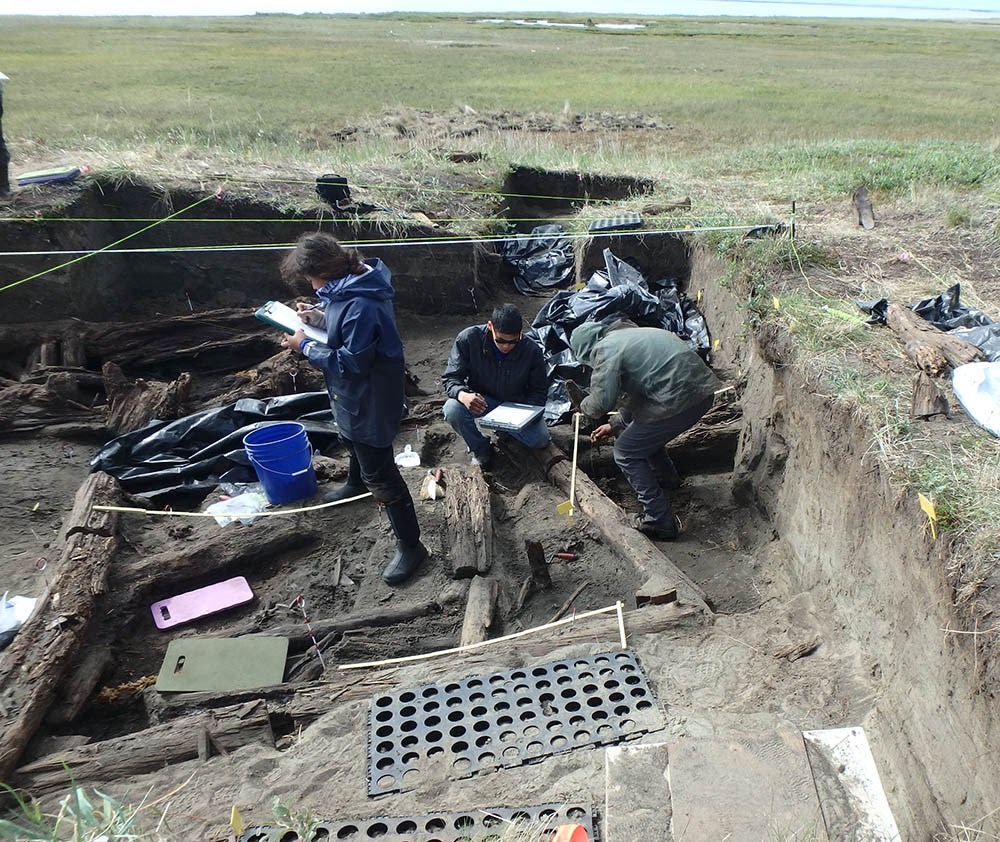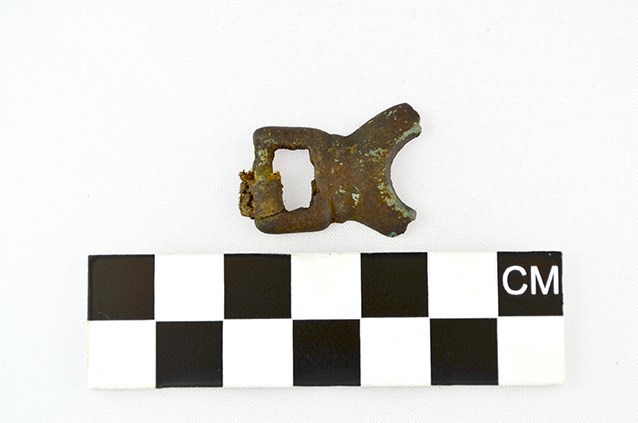Last updated: April 10, 2019
Article
Eurasian Metal Found in Ancient Alaska
By H. Kory Cooper, Purdue University; Owen K. Mason, University of Colorado; Victor Mair, University of Pennsylvania; John F. Hoffecker, University of Colorado; Robert J. Speakman, University of Georgia
Excavations at Cape Espenberg on the northwest coast of Alaska between 2009 and 2011 recovered thousands of wood, bone, ivory, antler, lithic, and ceramic artifacts. Six metal or composite metal artifacts were recovered including a bone fishing lure with iron inset eyes; a piece of bone fishing tackle with a copper hook; an eyed copper needle; a small fragment of sheet copper; a copper alloy cylindrical bead; and a fragment of a small copper alloy buckle. The metal finds at Cape Espenberg are significant because the presence of smelted alloys in a prehistoric Inuit context in northwest Alaska is demonstrated here for the first time, indicating the movement of Eurasian metal across the Bering Strait into North America before sustained contact with Europeans.
Energy dispersive-x-ray fluorescence (ED-XRF) was performed on all five copper artifacts. The fish hook, needle, and small sheet fragment were identified as relatively pure copper, but the analysis was unable to determine definitively whether they were native copper (naturally occurring pure copper) or smelted copper (i.e., an industrial product). We identified the cylindrical bead and buckle fragment definitively as industrial smelted alloys, specifically, leaded bronze, an alloy of copper, tin, and lead. By weight, the buckle consists of nearly 45% lead, 20% tin, a few percent arsenic and silver, and 24% copper, while the bead is composed of about 30% lead, 18% tin, and 47% copper.
On the basis of its morphology, the buckle was suspected to have been cast in a mold, which would make it an industrial product and an unprecedented find in Alaskan prehistory. Accordingly, high priority was placed on non-destructive analysis to identify its composition and determine if it could have been made with naturally occurring copper from Alaska or the Canadian Arctic.
Excavations at Cape Espenberg on the northwest coast of Alaska between 2009 and 2011 recovered thousands of wood, bone, ivory, antler, lithic, and ceramic artifacts. Six metal or composite metal artifacts were recovered including a bone fishing lure with iron inset eyes; a piece of bone fishing tackle with a copper hook; an eyed copper needle; a small fragment of sheet copper; a copper alloy cylindrical bead; and a fragment of a small copper alloy buckle. The metal finds at Cape Espenberg are significant because the presence of smelted alloys in a prehistoric Inuit context in northwest Alaska is demonstrated here for the first time, indicating the movement of Eurasian metal across the Bering Strait into North America before sustained contact with Europeans.
Energy dispersive-x-ray fluorescence (ED-XRF) was performed on all five copper artifacts. The fish hook, needle, and small sheet fragment were identified as relatively pure copper, but the analysis was unable to determine definitively whether they were native copper (naturally occurring pure copper) or smelted copper (i.e., an industrial product). We identified the cylindrical bead and buckle fragment definitively as industrial smelted alloys, specifically, leaded bronze, an alloy of copper, tin, and lead. By weight, the buckle consists of nearly 45% lead, 20% tin, a few percent arsenic and silver, and 24% copper, while the bead is composed of about 30% lead, 18% tin, and 47% copper.
On the basis of its morphology, the buckle was suspected to have been cast in a mold, which would make it an industrial product and an unprecedented find in Alaskan prehistory. Accordingly, high priority was placed on non-destructive analysis to identify its composition and determine if it could have been made with naturally occurring copper from Alaska or the Canadian Arctic.


NPS photo
The iron eyes in the fish lure were analyzed using a handheld Bruker x-ray fluorescence (XRF) spectrometer to eliminate meteoritic iron as a possible source. Iron meteors may contain several percent nickel (Ni); at a minimum they contain 5%. The iron used to make the eyes was determined to be non-meteoritic iron due to the very small amount of nickel detected (<1%), and therefore an industrial smelted product.
Acknowledgements
This research was a collaborative effort between two projects funded by the Office of Polar Programs at the National Science Foundation: the Cape Espenberg Project (ARC-0755725) awarded to John Hoffecker and Owen Mason, and an investigation of metallurgical innovation in the Arctic and Subarctic (ARC-1108250) awarded to H. Kory Cooper.
